The inflammatory response in stroke
- PMID: 17188755
- PMCID: PMC1868538
- DOI: 10.1016/j.jneuroim.2006.11.014
The inflammatory response in stroke
Abstract
Recent works in the area of stroke and brain ischemia has demonstrated the significance of the inflammatory response accompanying necrotic brain injury. Acutely, this response appears to contribute to ischemic pathology, and anti-inflammatory strategies have become popular. This chapter will discuss the current knowledge of the contribution of systemic and local inflammation in experimental stroke. It will review the role of specific cell types including leukocytes, endothelium, glia, microglia, the extracellular matrix and neurons. Intracellular inflammatory signaling pathways such as nuclear factor kappa beta and mitogen-activated protein kinases, and mediators produced by inflammatory cells such as cytokines, chemokines, reactive oxygen species and arachidonic acid metabolites will be reviewed as well as the potential for therapy in stroke and hypoxic-ischemic injury.
Figures


References
-
- Adibhatla RM, Hatcher JF, Larsen EC, Chen X, Sun D, Tsao FH. CDP-choline significantly restores phosphatidylcholine levels by differentially affecting phospholipase A2 and CTP: phosphocholine cytidylyltransferase after stroke. J Biol Chem. 2006;281:6718–6725. - PubMed
-
- Albelda SM. Endothelial and epithelial cell adhesion molecules. Am J Respir Cell Mol Biol. 1991;4:195–203. - PubMed
-
- Allan SM, Rothwell NJ. Cytokines and acute neurodegeneration. Nat Rev Neurosci. 2001;2:734–744. - PubMed
-
- Asahi M, Asahi K, Jung JC, del Zoppo GJ, Fini ME, Lo EH. Role for matrix metalloproteinase 9 after focal cerebral ischemia: effects of gene knockout and enzyme inhibition with BB-94. J Cereb Blood Flow Metab. 2000;20:1681–1689. - PubMed
-
- Asahi M, Sumii T, Fini ME, Itohara S, Lo EH. Matrix metalloproteinase 2 gene knockout has no effect on acute brain injury after focal ischemia. Neuroreport. 2001;12:3003–3007. - PubMed
Publication types
MeSH terms
Substances
Grants and funding
LinkOut - more resources
Full Text Sources
Other Literature Sources
Medical

